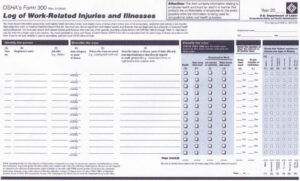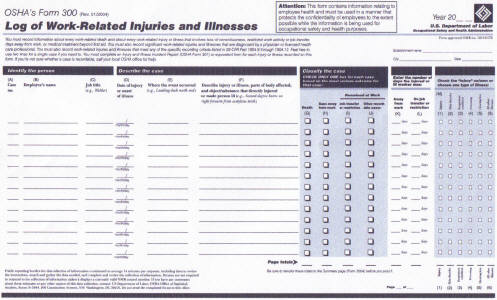According to Dr. David Michaels, Assistant Secretary of Labor for Occupational Safety and Health, “Accurate records are not simply paperwork, but have an important, in fact, life-saving purpose. They will enable employers, employees, researchers and the government to identify and eliminate the most serious workplace hazards – ones that have already caused injuries and illnesses to occur.”
When a workplace incident occurs, documenting as much detail as possible, such as who, what, where, and when an incident occurred, allows for preventative steps to be implemented. Employers are required to keep accurate records of workplace illness and injuries for up to five years from when the incident occurred.
OSHA 300 forms are the reporting forms employers must submit to OSHA when an illness and/or injury occurs from a workplace incident. It’s important to note that employers with fewer than ten full time employees are exempt from OSHA 300 form reporting.
The three different OSHA 300 forms are listed below with descriptions.
 OSHA 300 – Comprehensive log of work related injuries and illnesses. The form identifies the person, describes the case, classifies the case, accounts the number of days the worker was away from work, and details the type of injury. Employers must keep the log updated with all workplace illness and injuries.
OSHA 300 – Comprehensive log of work related injuries and illnesses. The form identifies the person, describes the case, classifies the case, accounts the number of days the worker was away from work, and details the type of injury. Employers must keep the log updated with all workplace illness and injuries.
OSHA 300A – Summary of the OSHA 300 form must be posted for employees by February 1 of the year following the year covered by the form, and employers must keep it posted until April 30 of that year.
OSHA 301 – Detailed injury and illness injury report. Sensitive information is recorded on the OSHA 301 form and all sensitive information must be kept confidential. This form must be completed if any of the following result from a workplace incident: death, loss of consciousness, professional medical treatment beyond first aid, or one or more days of lost work beyond the incident date.
Quantum’s Incident Reporting/Investigation/Corrective Action Module The completed forms can even be uploaded into the system so companies can reprint the forms to show compliance when asked to do so. For more information on how a good incident reporting system can improve safety culture within an organization, click here to read an article written by my colleague, Cassandra Seltzer.







